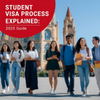
Thinking of studying abroad but confused about the visa process? You’re not alone. Navigating the complex documentation and deadlines can feel overwhelming. That’s why we’ve got the entire student visa process explained—from application to approval—so you can confidently start your international education journey.
Whether you’re heading to Italy, Canada, the UK, or Australia, this guide answers the most pressing questions students have and helps you avoid costly mistakes.
Why Understanding the Student Visa Process Matters
Securing a student visa is not just a formality—it’s your legal entry ticket to studying in another country. Missing just one document or timeline could delay or jeopardize your admission. With student visa rejection rates rising in some countries due to insufficient documentation, being well-prepared is essential.
Step 1: Secure Admission to a Recognized Institution
Before you can apply for a visa, you must have an official admission offer from a government-recognized university or college.
- Ensure your institution is accredited.
- You’ll usually need an offer letter or Confirmation of Enrollment (COE).
- For non-English-speaking countries, additional language requirements (e.g., Italian or German proficiency) may apply.
Step 2: Understand Your Destination’s Visa Type
Each country has its own visa categories:
- USA: F-1 Student Visa
- UK: Student Route (Tier 4)
- Canada: Study Permit
- Italy: National Type-D Student Visa
- Australia: Subclass 500
Understanding your specific visa type helps ensure you collect the correct documentation and follow the right application procedure.
Step 3: Prepare Essential Documents
One of the most critical steps is compiling the correct set of documents. Here’s what most countries require:
- Valid passport (with at least 6 months’ validity)
- Acceptance letter from your educational institution
- Proof of financial means (bank statements, loan approval, or sponsorship)
- Visa application form and fee receipt
- Passport-size photographs (in prescribed format)
- Health insurance proof
- Language proficiency test scores (IELTS, TOEFL, etc.)
- Police clearance certificate in some countries
Step 4: Apply for the Visa
Applications can be online or via embassy/consulate submission. Here’s a typical sequence:
- Create an online account (for countries like Canada or Australia)
- Upload documents and fill in personal details
- Pay the visa fee
- Book and attend your biometric appointment (fingerprints, photo)
- Schedule a visa interview (for countries like the USA)
Step 5: Attend the Visa Interview (If Applicable)
Countries like the USA require an interview at their consulate. To improve your chances:
- Answer honestly and confidently
- Clearly state your academic intentions and return plans
- Show proof of funds and ties to your home country
Step 6: Wait for Approval and Prepare for Departure
Once your visa is approved:
- You’ll receive a visa sticker or electronic approval
- Check the visa validity and travel window
- Book your flight and finalize accommodation
- Print your visa documents and keep digital copies
Common Mistakes That Lead to Visa Rejection
To improve your success rate, avoid these pitfalls:
- Submitting incomplete or forged documents
- Insufficient proof of financial support
- Unclear purpose of visit or study plan
- Weak academic credentials
- Poor visa interview performance
How Eduvisor Makes the Visa Journey Smoother
Navigating international visa processes can be daunting, but Eduvisor makes it easier. As a trusted study abroad consultant, we offer:
- Personalized visa counseling based on your destination
- Help with document preparation and financial proof
- Pre-interview mock sessions and embassy-specific advice
- Real-time updates on country-specific visa rules
Eduvisor’s experts stay up to date with every immigration policy change—ensuring your visa journey is as seamless as your academic one.
Frequently Asked Questions (FAQ)
1. What is the average processing time for a student visa?
Most student visas take between 3–6 weeks. However, delays can occur during peak seasons.
2. Can I work while studying on a student visa?
Yes, many countries allow part-time work—usually up to 20 hours/week during term and full-time during holidays.
3. Is it possible to bring dependents on a student visa?
Countries like Australia and Canada allow dependents, but additional documents and finances are required.
4. What happens if my visa is rejected?
You can reapply, but it’s crucial to address the rejection reasons. Eduvisor helps analyze refusal letters and strengthen your reapplication.
5. Can I apply for permanent residency after my studies?
Yes, several countries offer post-study work permits that can lead to permanent residency. Canada’s PGWP and Australia’s TR visas are good examples.
Final Thoughts: Apply Smart, Study Confidently
Getting the student visa process explained is your first step toward global education success. It requires planning, documentation, and support—but the reward is life-changing. Avoid uncertainty by preparing thoroughly and leaning on experienced professionals.
At Eduvisor, we don’t just help you get your visa—we help you secure your future. Connect with our team today for tailored guidance on your dream study destination.
Comment your thoughts, bookmark this guide, or share it with a friend preparing for their study abroad journey!

